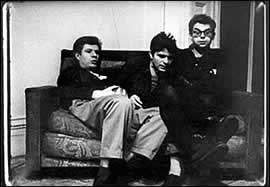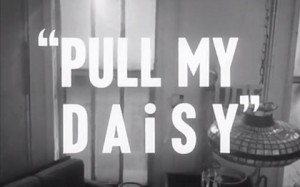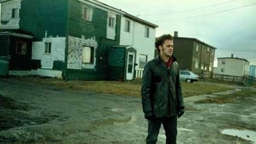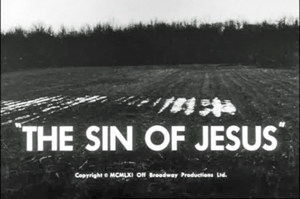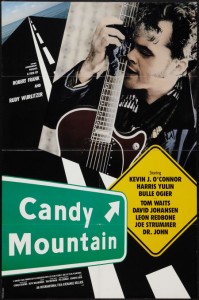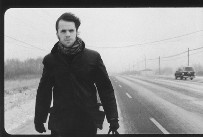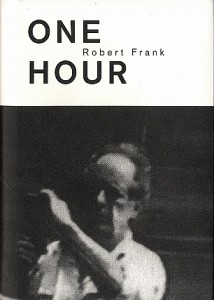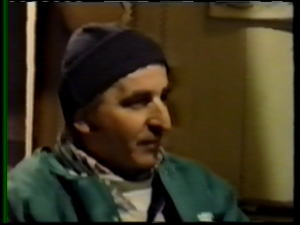Commissioned by MUBI Notebook for November 18, 2019. — J.R.
“How much of this film is composed, and how much is improvised?” The obvious question posed by Robert Frank’s first film (coauthored by painter Alfred Leslie), Pull My Daisy (1959), is also posed, sometimes less obviously, by the authored and coauthored Frank films that follow it—an unwieldy filmography that has on occasion become even harder to access because of the unwieldy ways it was financed or put together. (Most notoriously, Cocksucker Blues, produced by the Rolling Stones to chronicle their own 1972 North American tour, has been banned by them from most venues.) To wonder whether they’re Frank or frank is arguably another way of interrogating their relative degrees of sincerity or subterfuge, non-fiction or fiction, single or collective authorship. And it’s ultimately our call whether any given shot in a Frank film corresponds to a declarative statement or a question—something that might also apply to his better known, more celebrated, and noncollaborative still photography. “After seeing these pictures,” wrote Jack Kerouac of The Americans, “you end up finally not knowing any more whether a jukebox is sadder than a coffin.” But whereas most or all the Frank photographs I’ve seen are recognizably his, each successive Frank film is a reinvention of what the art of film might consist of. One could even say that his twenty-odd films range from ambitious to disposable, from joyful to bleak, and from artificial constructions to intimate home movies. Sometimes, with a bit of angry bravado and concerted autodestruction, they insist on being all these things at once. The half-hour, autobiographical About Me: A Musical (1970), for instance, casts a young actress to play a middle-aged Frank and both is and isn’t a musical. Some others virtually invite us to misunderstand or be ignored by them.
But let’s start with Pull My Daisy, one of the more accessible ones. Its silent images, beginning with a leftward pan across Alfred Leslie’s flat, follow a jazz tune composed by David Amram, partly improvised by a saxophonist, and given lyrics by Allen Ginsberg and Jack Kerouac that are sung by Anita Ellis. Then the stationary camera setups of a table, a kitchen, and Delphine Seyrig accompany a hilarious improvised monologue by Kerouac, who saw the film’s silent images twice before he began to ramble, thus giving him some opportunity to precompose his free-forming spiel. Yet the film’s skeletal plot is said to be derived from the third act of a Kerouac play, making its seeming randomness even more uncertain.
How much Pull My Daisy also qualifies as Leslie’s film and/or Kerouac’s has never been settled, Similar questions can be raised about Keep Busy (1975), Energy and How To Get It (1981), and Candy Mountain (1987), all of which credit novelist Rudy Wurlitzer as sole writer and codirector. (Such questions have been exacerbated by Frank having subsequently fallen out with both Leslie and Wurlitzer; having myself heard only Leslie’s and Wurlitzer’s versions of what transpired on Daisy and Mountain, I can only say that I found their separate grievances convincing.)
Frank’s next two early films regressively imitate the fashionable art cinema of the period — Ingmar Bergmanesque allegory in The Sin of Jesus (1961), Michelangelo Antonioni-like alienation in OK End Here (1963). Then his first feature, Me and My Brother (1968)–made over several years and focusing on Julius Orlovsky, the catatonic brother of Allen Ginsberg’s longtime partner Peter Orlovsky–expands the issues of improvisation versus composition, documentary versus fiction, and collaboration versus self-expression with a vengeance. Using actors to portray some of the “real” characters, including theater director Joseph Chaiken doubling as Julius and early appearances by Christopher Walken and Roscoe Lee Browne (after having previously cast a young Terry Savalas in The Sin of Jesus), Frank only underlines his uneasy split between avant-garde and arthouse allegiances that have sometimes banished his films from both realms, often landing him in the museum/gallery circuits that support his still photography.
The hapless hero of Candy Mountain, Julius Book (Kevin J. O’Connor), makes a journey north from New York into the remote Canadian wilderness in search of a legendary guitar maker named Elmore Silk (Harris Yulin), at the request of and subsidized by some music entrepreneurs who want Silk to resume his craft. Book’s journey moves backward in time as well as forward, and every stage is informed by evocations of other times and places. Significantly, the main vehicles in these parallel trajectories toward the future and the past are a series of cars, vans, and trucks and a single cassette recorder bearing messages from Silk’s former associates in New York. As Book travels north, he encounters discarded friends, lovers, and relatives of Silk, who record their own messages for him. Book also records his own ruminations, fantasy projections, and bulletins of his progress on the same cassette, and in a way this collection of voices represents the culture that Silk fled. But the different voices are also a series of stepping stones that mark Book’s journey, leading him and us to the elusive Silk. When Silk eventually plays the tape back, the parallel portraits of his gradual retreat into the wilderness and the reasons for that retreat are equally evident.
My favorite Frank film, known variously as One Hour and C’est vrai, captures downtown Manhattan even more indelibly than Pull My Daisy. My first look at this single-take account of Frank and Kevin O’Connor walking or riding in the back of a mini-van through a few blocks — shot between 3:45 and 4:45 pm on July 26, 1990 —led me to interpret it mainly as a spatial event capturing the somewhat uncanny coziness and intimacy of New York street life, where eavesdropping involuntarily on strangers seems an essential part of being on an island where so many people are crammed together that the existential challenge of everyday coexistence between them seems central to the city’s nervous energy and excitement. But then I came across a tiny book comprising 74 pages of transcripted dialogue and two pages of credits (for half a dozen crew members and 27 actors), with an acknowledgment that the film actually had a script, even though the lines of Peter Orlovsky (intercepted by Frank in front of the Angelika Cinema on Houston Street) — who gradually wrests the film’s apparent center away from O’Connor — are “total improvisation”.
And here’s where the real mysteries begin. How much of Frank’s apparently random drift is precisely plotted, how many seeming chance encounters are staged and intricately coordinated, and how much of what we see and hear is extemporaneous? The volatile, unstable mixtures of chance and control can never be entirely sorted out. How much is this is a tossed-off home movie about Frank’s own neighborhood, and how much it’s a contrived board game spread out over several city blocks, ultimately becomes a metaphysical question. And the fact that we often can’t distinguish between the open searches and the found objects — a dilemma posed equally by such diaristic ventures as The Present (1996) and True Story (2004) — guarantees that we remain as much in the dark (or in the light) as Frank is.

